MCAT Physics
1/139
There's no tags or description
Looks like no tags are added yet.
Name | Mastery | Learn | Test | Matching | Spaced |
|---|
No study sessions yet.
140 Terms
Degrees - Radians - Sine - Cosine - Tangent
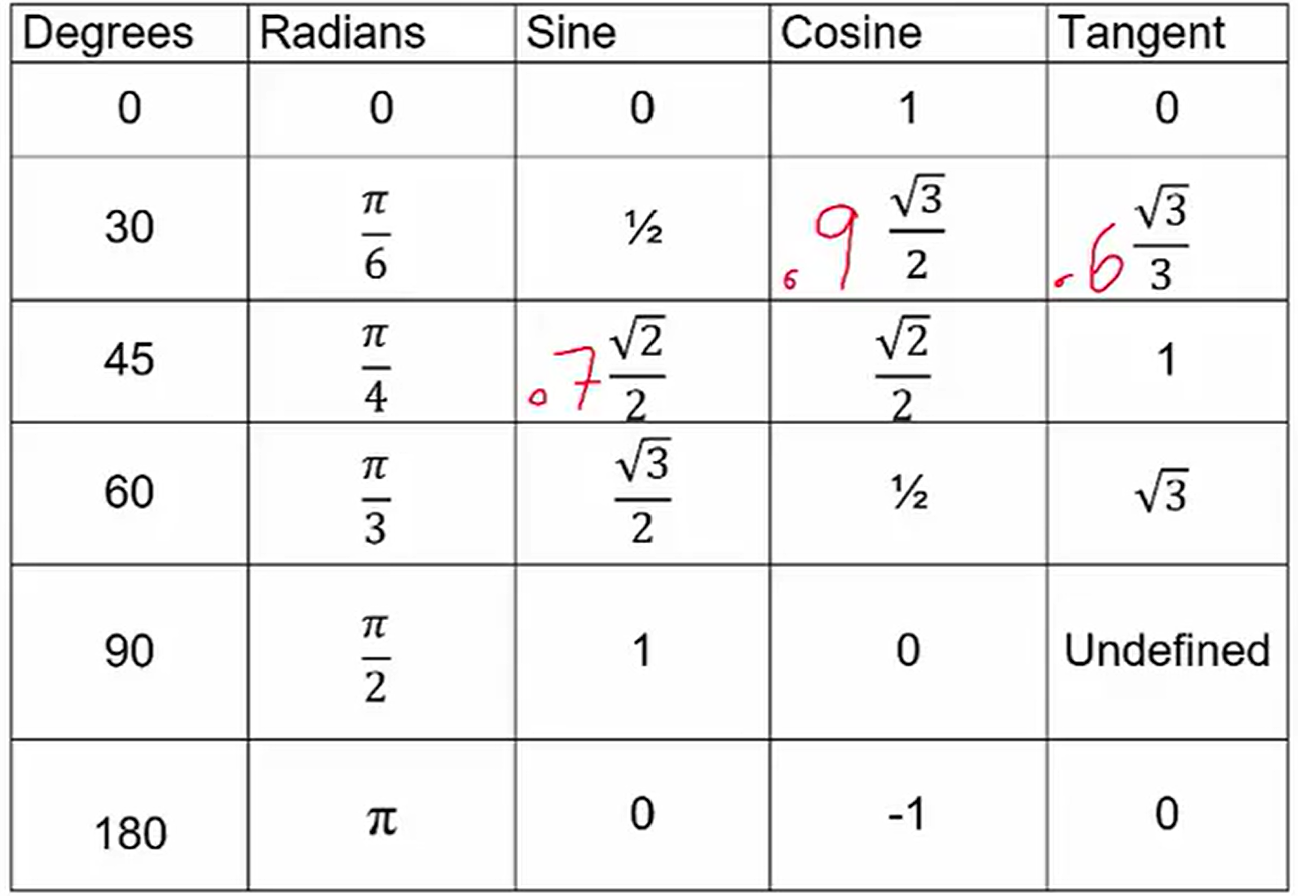
SOH CAH TOA
Sine = Opposite / Hypotenuse
Cosine = Adjacent / Hypotenuse
Tangent = Opposite / Adjacent
Two Special Right Triangles
45-45-90
30-60-90
The 45-45-90 Triangle
1 - 1 - sqrt(2) triangle for the lengths of the sides
sin(45) = sqrt(2) / 2 = cos(45) [both the same]
tan(45) = 1
If theta < 45, then tan(theta) < 1
If theta > 45, then tan(theta) > 1
The 30-60-90 Triangle
1 - sqrt(3) - 2 triangle for the lengths of the sides
sin(30) = ½ ; cos(30) = sqrt(3) / 2 ; tan(30) = sqrt(3) / 3
cos(30) > sin(30) and tan(30) < 1
sin(60) = sqrt(3) / 2 ; cos(60) = ½ ; tan(60) = sqrt(3)
cos(60) < sin(60) and tan(60) > 1
Decimal Approximations:
sqrt(2)
sqrt(3)
sqrt(3) / 3
sqrt(2) / 2
sqrt(3) / 2
sqrt(2) = 1.4
sqrt(3) = 1.7
sqrt(3) / 3 = 0.577
sqrt(2) / 2 = 0.7
sqrt(3) / 2 = 0.866 = 13/15
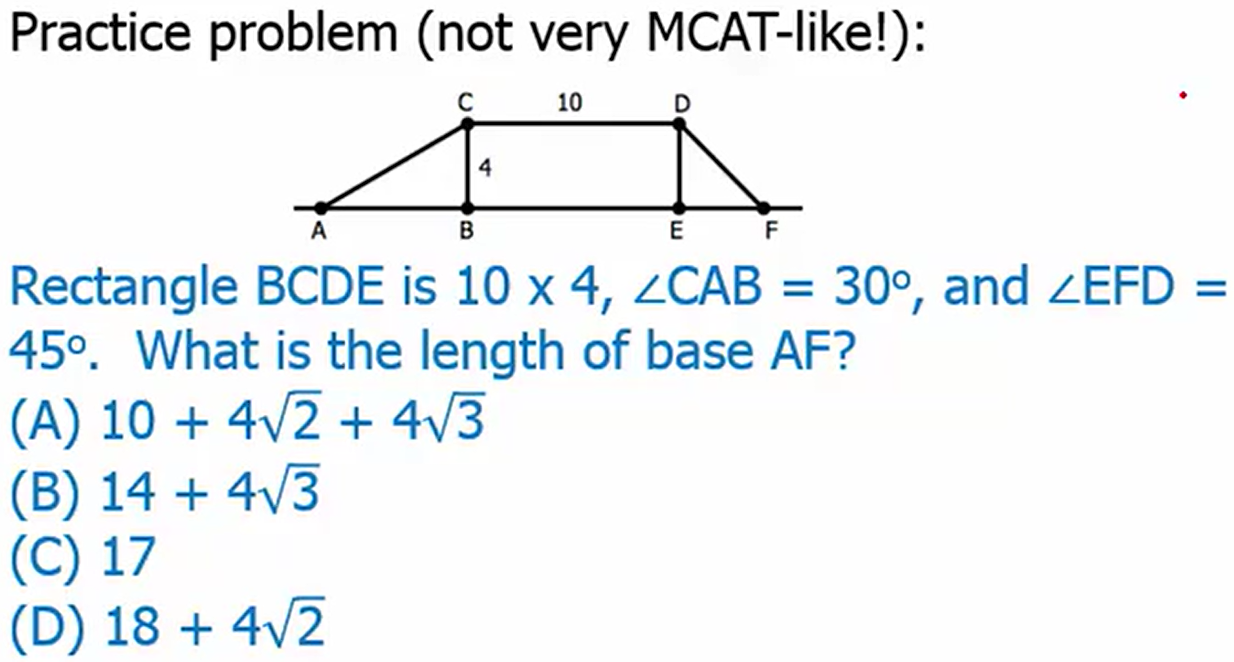
B. 14 + 4(sqrt(3))
Ratio of AB to BC is sqrt(3) : 1, so we must multiple by 4 to get BC = 4 so AB = 4 x sqrt(3)
N = bk solve for b and k
logb(N) = k

Limit the Bases
Common logs (base 10): written log (N), that is, w/o any explicit base
Natural logs (base e): written ln(N)
The number e (Euler’s constant)
e = ~2.718
Common Logs
log(10) = 1
log(100,000) = 5
log(1/100) = log(10-2) = -2
N = 10k → log(10k) = k
substitute
log(N) = k → N = 10log(N)
If log(N) goes up by 1, this means N gets…
If log(N) goes up by 3, N gets…
If log(N) goes down by 1, N gets…
If log(N) goes down by 5, N gets…
10x bigger
1000x bigger
Divided by 10
Divided by 100,000
sqrt(10) = 101/2 → sqrt(10) = ~3
If log(N) increases by 1/2, then N is multiplied by ~3
If log(N) decreases by 1/2, then N is divided by ~3
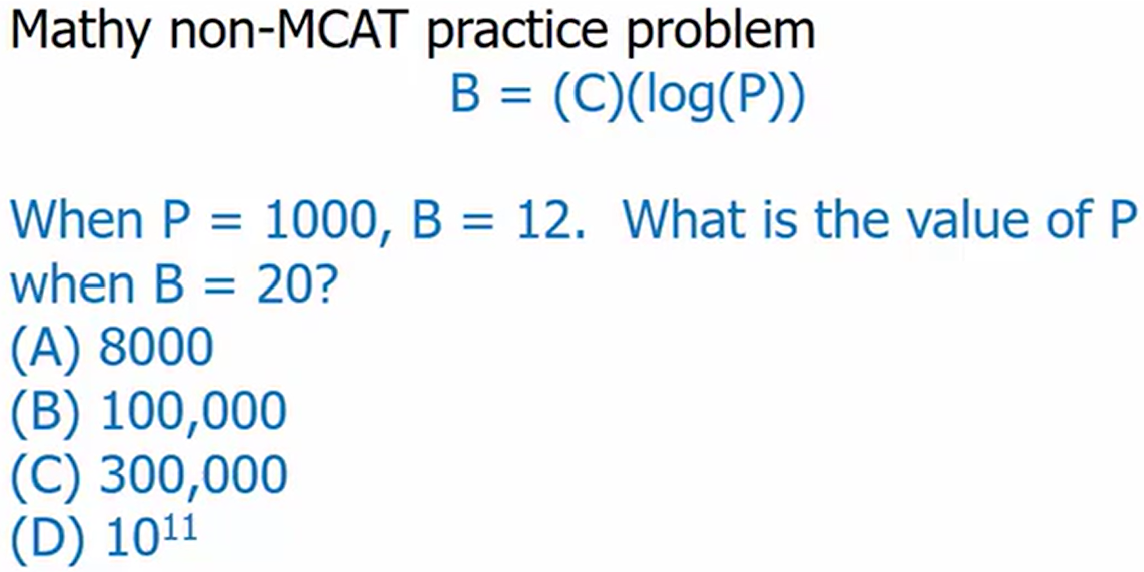
B. 100,000
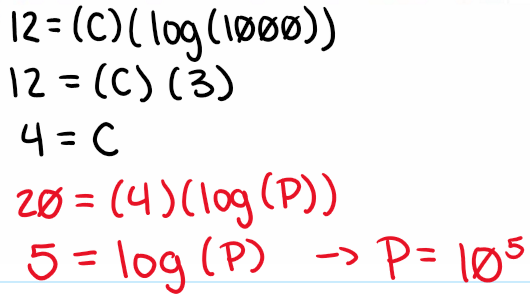
pH = -log[H+]
When pH goes down, the concentration of H+ ions goes up
pH < 7 = acidic and high # of H+ ions
pH > 7 = basic and small # of H+ ions
Sound Intensity and Decibels
B = 10 log(I / I0)
I = the intensity of the sound wave itself
I0 = the reference intensity, typically, the minimal threshold of human hearing
B = the decibel value, which approximates how loud the sound seems to human perception
For every additional factor of 10 bu which I is multiplied, we add 1 to the logarithm…
The 1 is then multiplied by 10, so multiplying I by 10N adds 10N to B (to the decibel)
Example:
Decibels increase by 25 = 2.5 has been added to the logarithm itself
Adding 2 means I is multiplied by 102 = 100 and adding 0.5 means I is multiplied by sqrt(10) = ~3
So I is multiplied by 300

B. 5.6
Increasing [H+] makes urine more acidic = lower pH
![<p>B. 5.6</p><p>Increasing [H<sup>+</sup>] makes urine more acidic = lower pH</p>](https://knowt-user-attachments.s3.amazonaws.com/392a4ec0-8ab0-47e2-b98c-191fc2398db4.png)
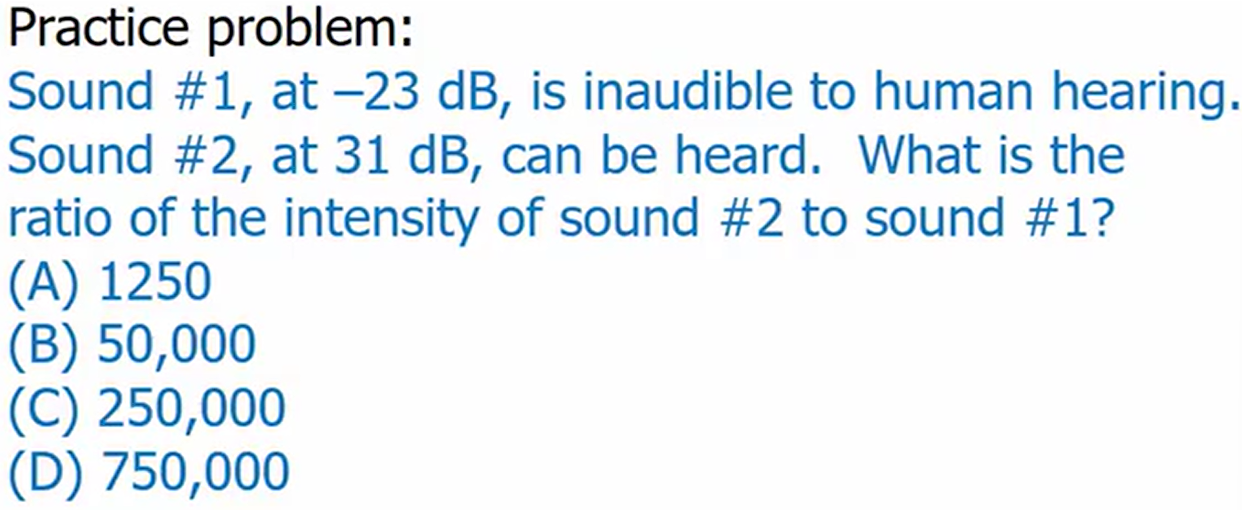
C. 250,000

Rules of Significant Figures
All non-zero digits shown are significant
All zeros between non-zero digits are automatically significant
Ordinarily, all place-holding zeros would NOT be significant
Zeros tot he right of both the decimal point and all non-zero digits have no place-holding role and would be shown only if they were significant
A line over a zero makes it a significant digit (or write the decimal)
Arithmetic with Significant Figures
Addition/Subtraction Rule
Place value: whichever term is measured to the least precise place limits the whole calculation
Multiplication/Division Rule
Number of digits: whichever factor has the fewest digits limits the digits in the result
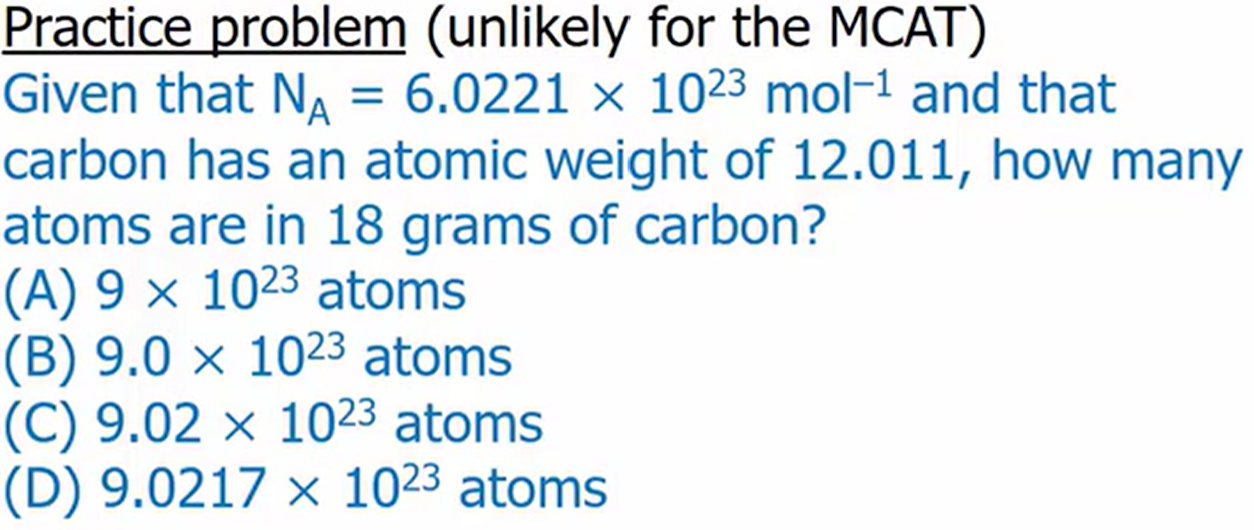
B. 9.0 × 1023 atoms
Basic Laws of Exponents:
Treat the number in front and the powers of tens separately

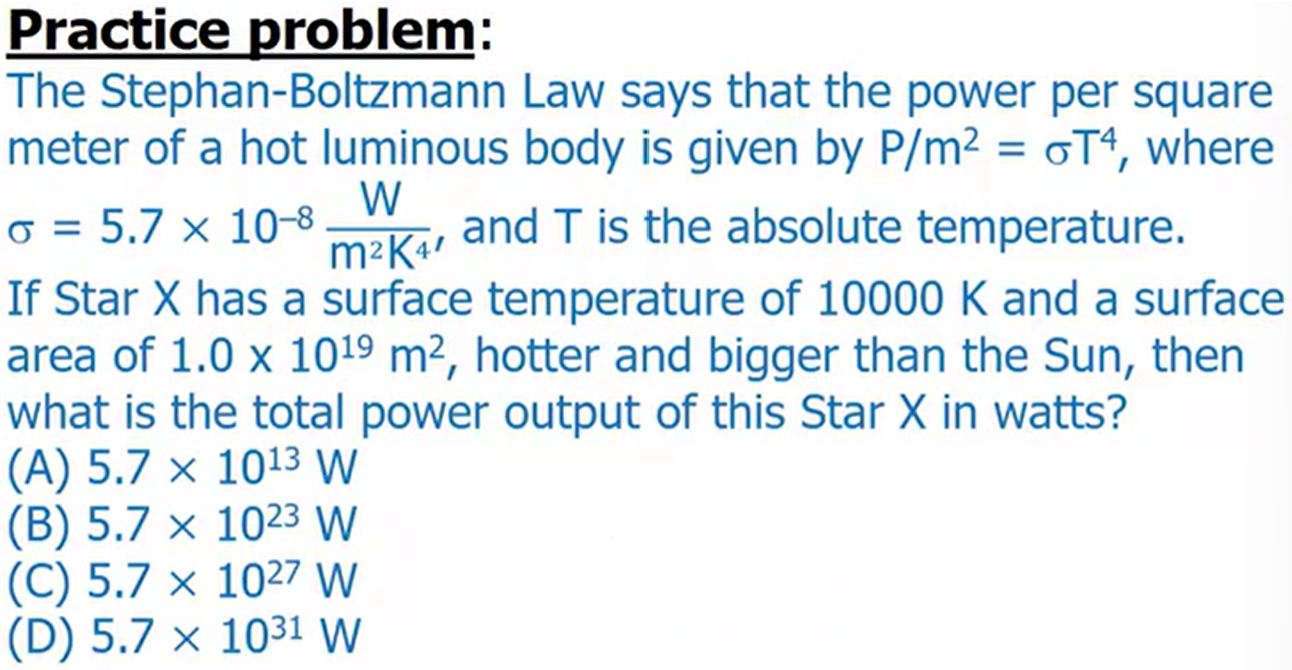
C. 5.7 × 1027 W

The most fundamental equation of motion is:
Distance = speed x time → x=vt
xT = x1 + x2
tT = t1 + t2
Can add individual distances or time, but can’t combine the individual speed to get a speed for the whole trip
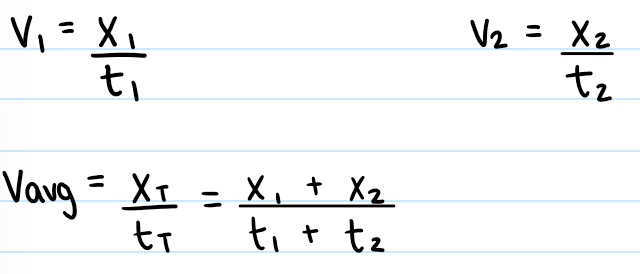
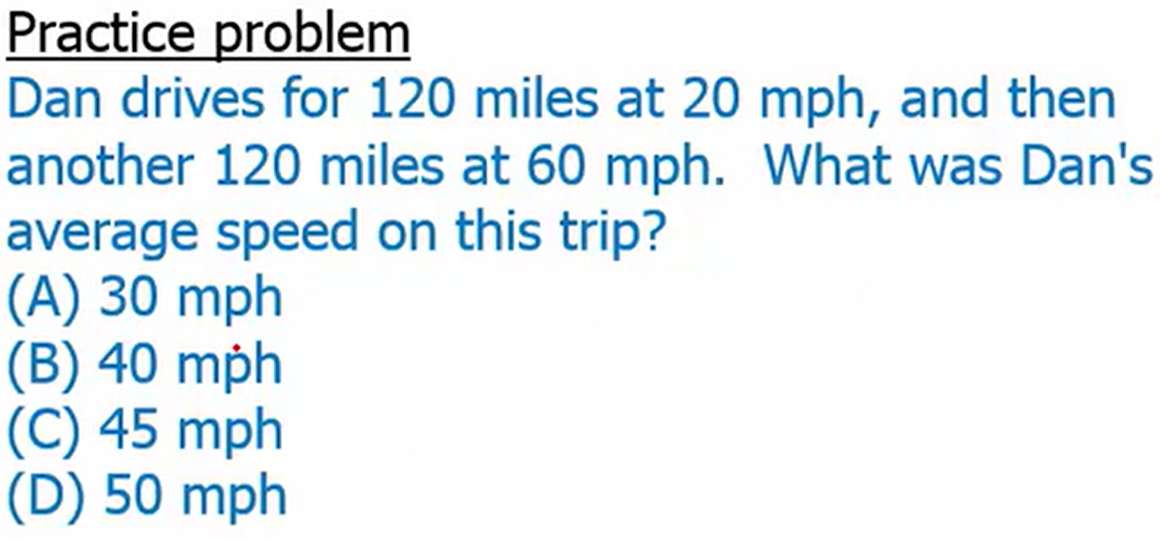
A. 30 mph

The fundamental equation for acceleration is:

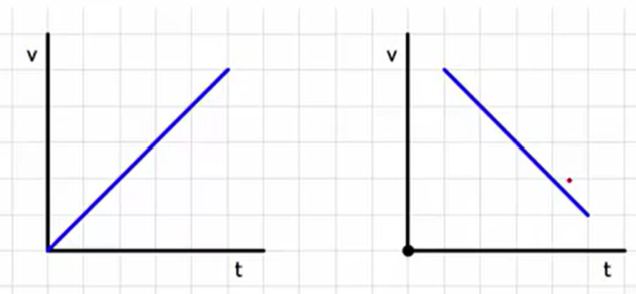
Uniform acceleration appears as a straight line on a v-vs-t graph
The slope on this graph equals the acceleration
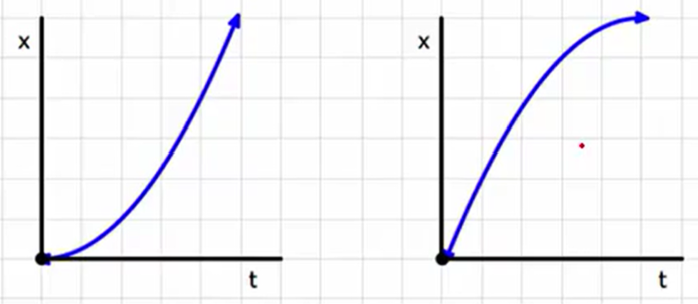
Uniform acceleration appears as a parabola on a x-vs-t graph
Slope = v
Right: v is increasing
Left: v is decreasing
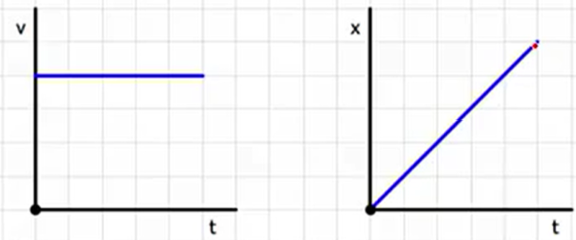
Constant speed appears as a straight line on x-vs-t graph and horizontal line on v-vs-t graph
Average Velocity Equation
Another equation: vf - vi = at

Time-Independent Equation
2axT = vf2 - vi2
Another Equation:
xT = ½ at2 + vit
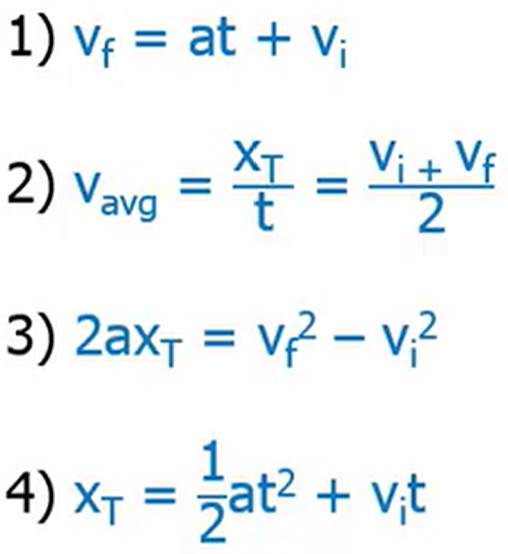
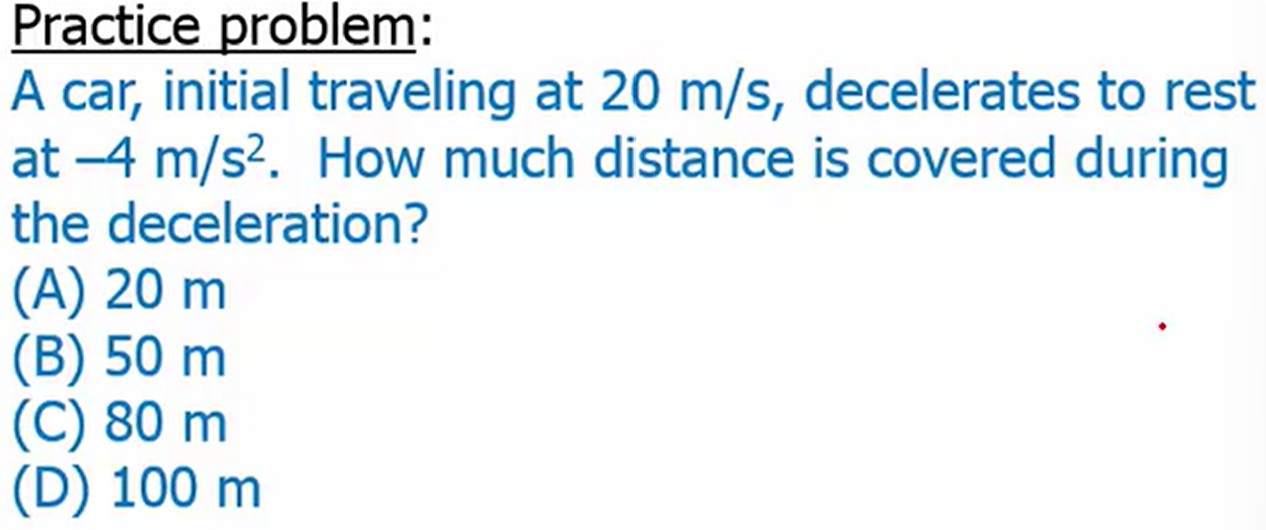
B. 50 m
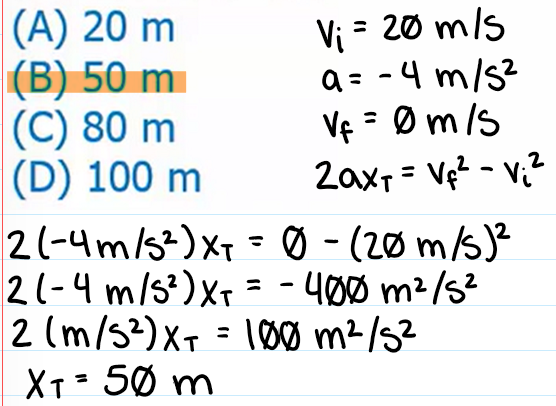
Gravitational Field
g = 9.8 m/s2 = ~10 m/s2
Freefall acceleration doesn’t depend on mass
For very light objects air friction is significant, so their motion cannot be considered true freefall
Over a large enough drop, any object will get fast enough to reach terminal velocity


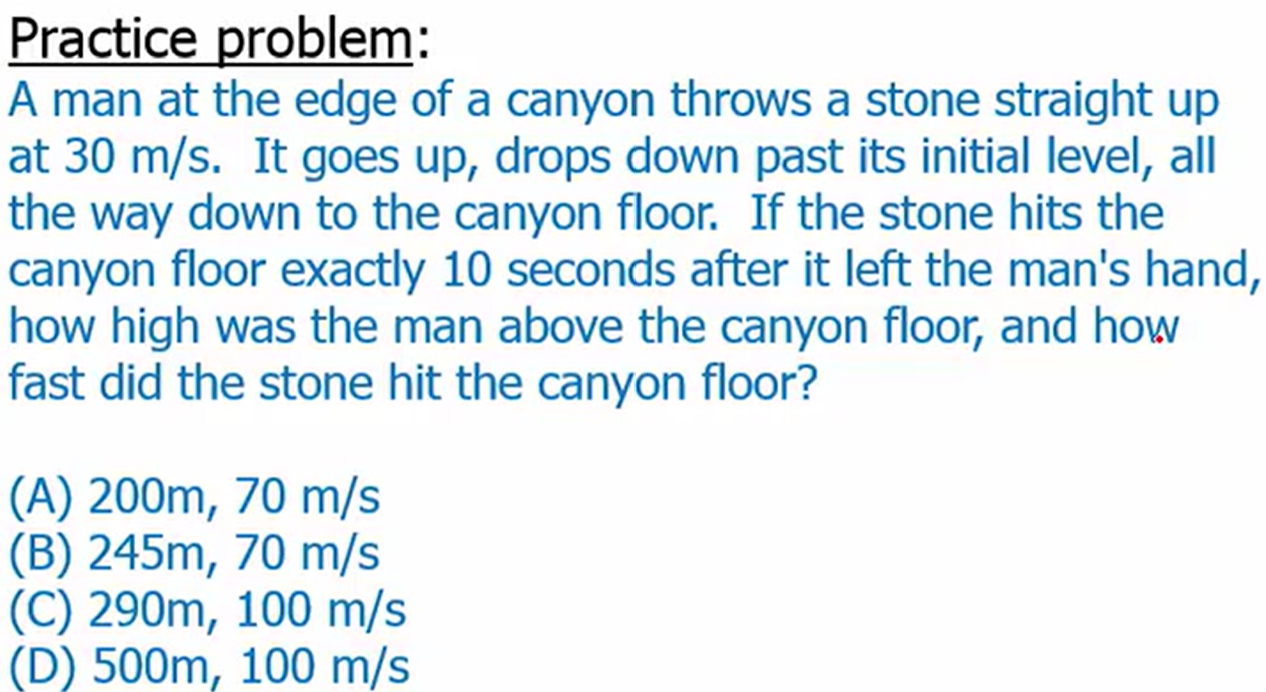
A. 200m, 70 m/s
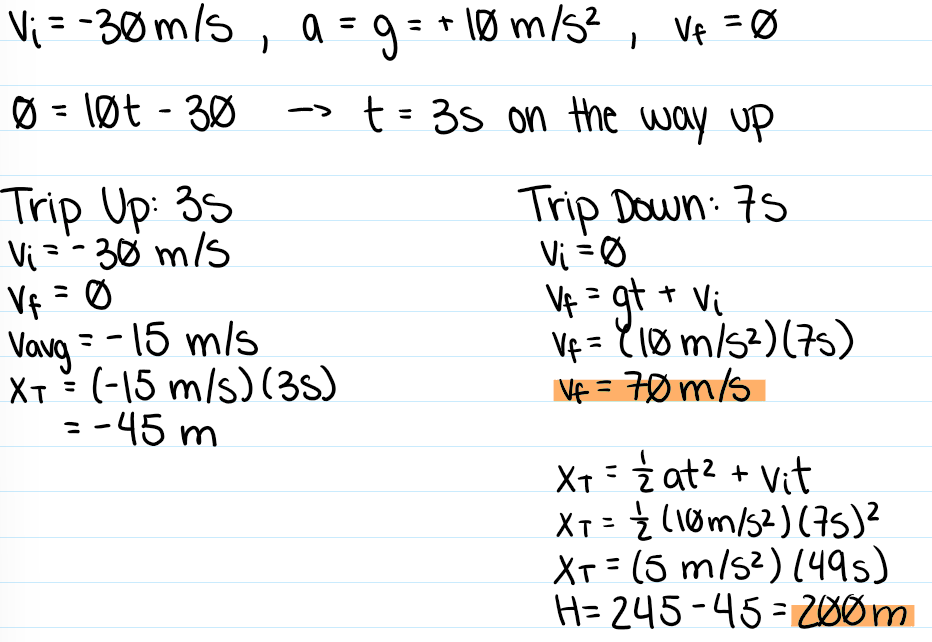
Scalars
Physical quantities for which direction is not meaningful
Vectors
Physical quantities that inherently have a direction
Vector Addition
Put arrows tip to tail
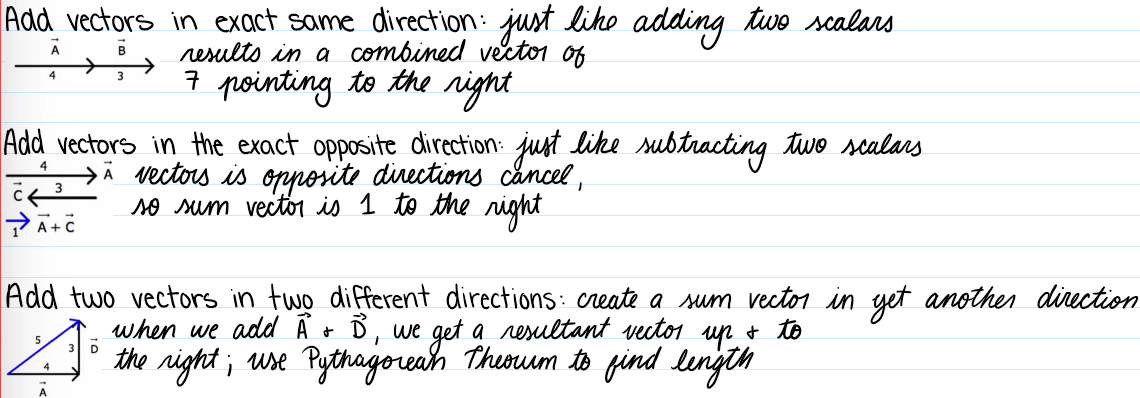


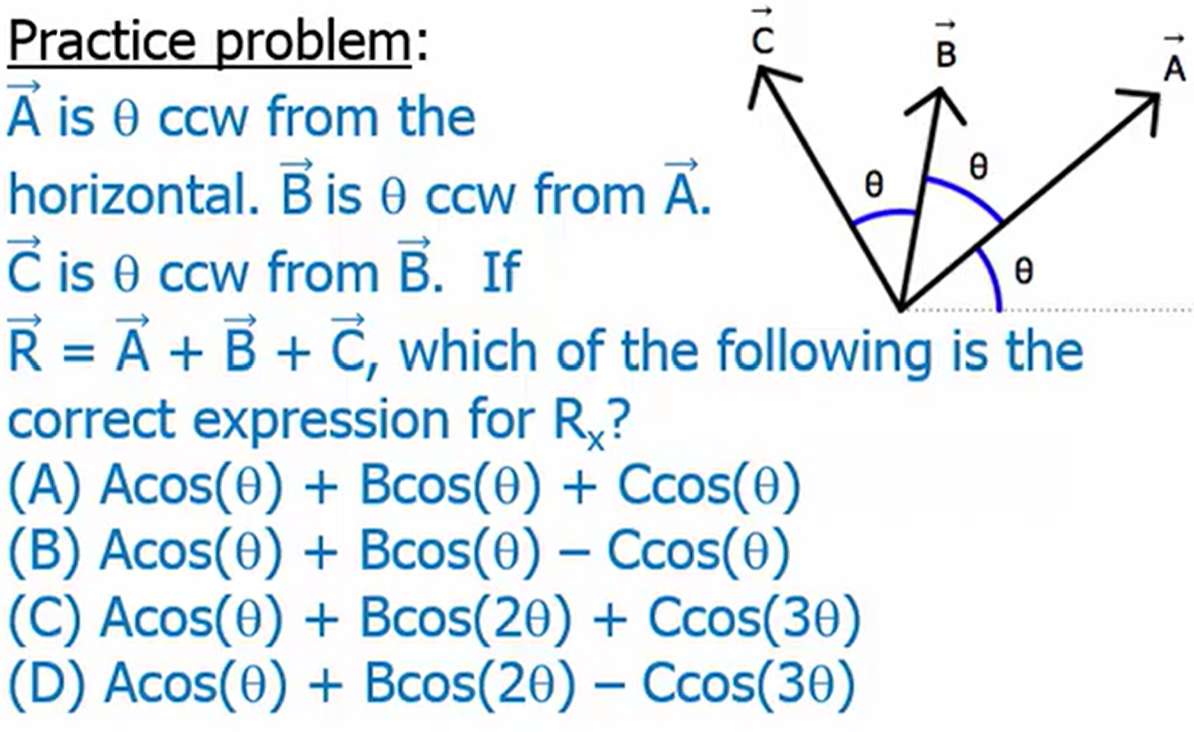
C. Acos(theta) + Bcos(2 theta) + Ccos(3 theta)
Distance vs Displacement
Distance: the total amount walked/driven on the ground
Displacement: the relationship of ending point to starting point
Speed, Velocity, and Acceleration Relationship
If you change speed, you change velocity
Can change velocity while maintaining a constant speed
Acceleration: time rate of change of velocity, not speed
ac = v2/r
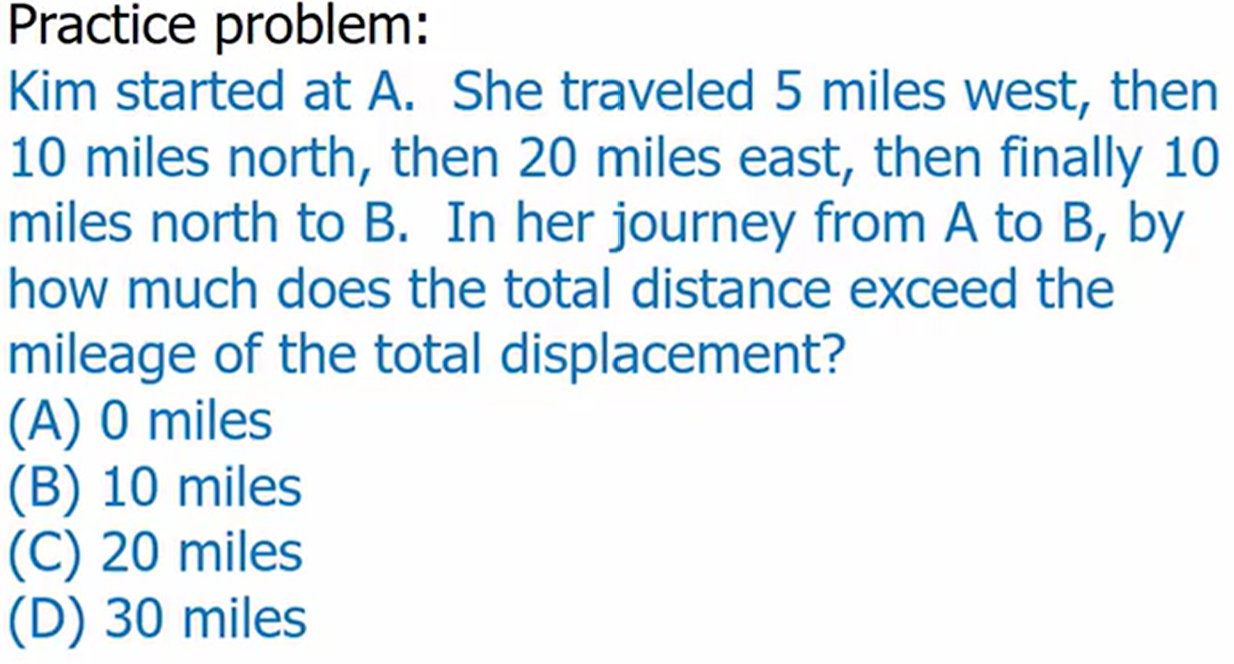

What are Dynamics?
Why things move
1 N = 1 (kg x m) / s2
Unit force is a newton
Newton’s First Law
“Law of Inertia”
An object at rest stays at rest, and an object in motion at a constant velocity stays in motion, unless acted upon by an unbalanced force
Inertia
The tendency of mass to resist changes in its state of motion
Balanced vs Unbalanced Forces
Balanced: No change in motion
Unbalanced: Change in motion
Newton’s Second Law
F = ma
F = vector sum of the forces on the object (the “net” force)
m = mass
a = acceleration
Newton’s Third Law
“The Law of Action and Reaction”
For every action, there is always an equal and opposite reaction
Applies to mechanical contact, gravitational, and electromagnetic forces
Weight
The force of attraction that Earth’s gravity exerts on this mass
Depends on mass and gravitational field: Weight (w) = Mass (m) x Gravity (g)
Normal Force
The weight of the object makes it press into the surface on which it is sitting causes the surface to push back on the object
N = w = mg
What if the surface is slanted?
If the horizontal surface is accelerating upward, then the net force has to be upward, so the normal force is slightly larger than the weight
If the horizontal surface is accelerating downward, then the net force has to be downward, so the normal force is slightly smaller than the weight


If forces are at angles:
Find or estimate components
If an object is at rest or constant velocity: the components in both x- and y-directions should sum to zero
If any acceleration is in one direction (x or y), then the components in the other direction will sum to zero
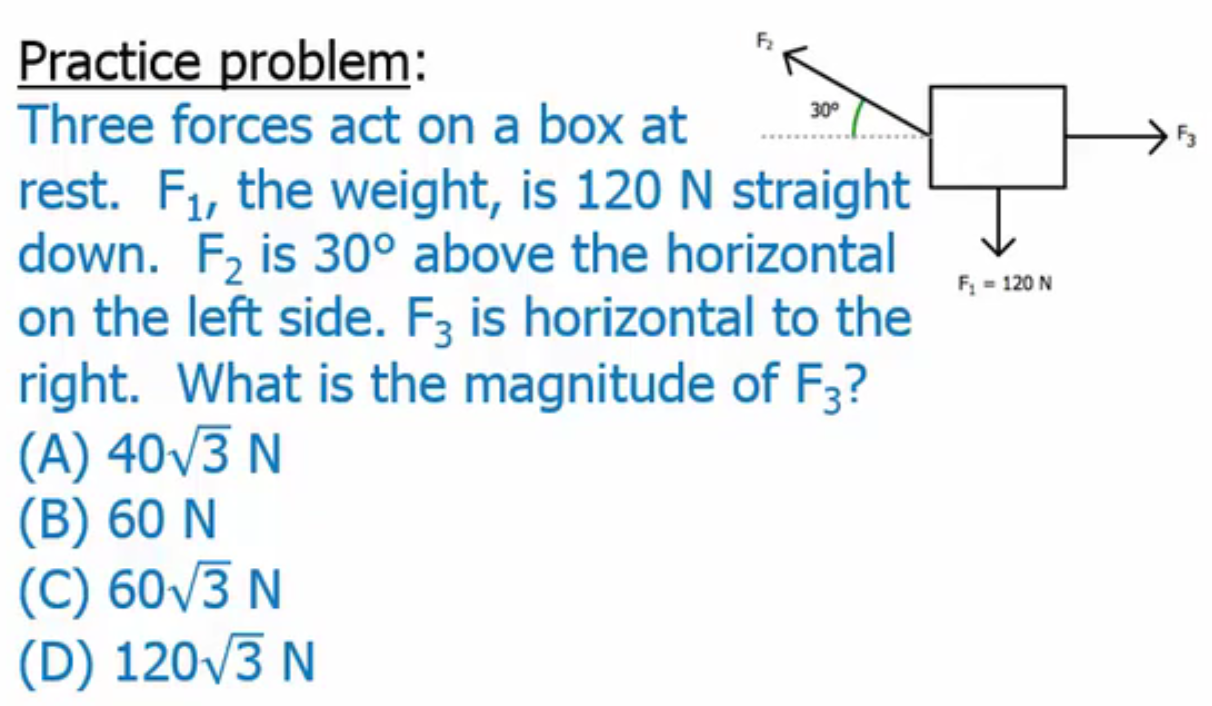
D) 120sqrt(3) N

Friction
A force that opposes motion
Arises from two surfaces rubbing together
f = uN
f = force of friction
N = normal force
u = coefficient of friction (between 0 and 1)
Close to zero for slippery surfaces
Larger for rough or sticky surfaces
Static Friction
The friction locking an object at rest
Need to be broken to initiate motion
us > uk
Kinetic Friction
The friction that happens once something is already sliding, in motion
us > uk
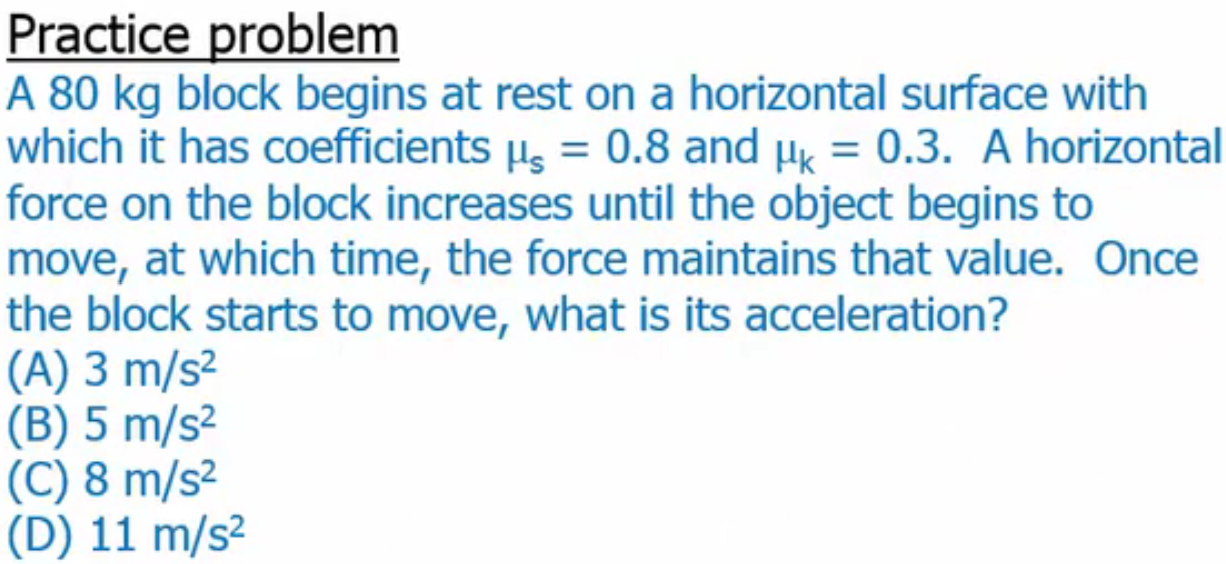
B) 5 m/s2

Free Body Diagrams
Represents the mass, the object, as a point
Represents all forces as arrows
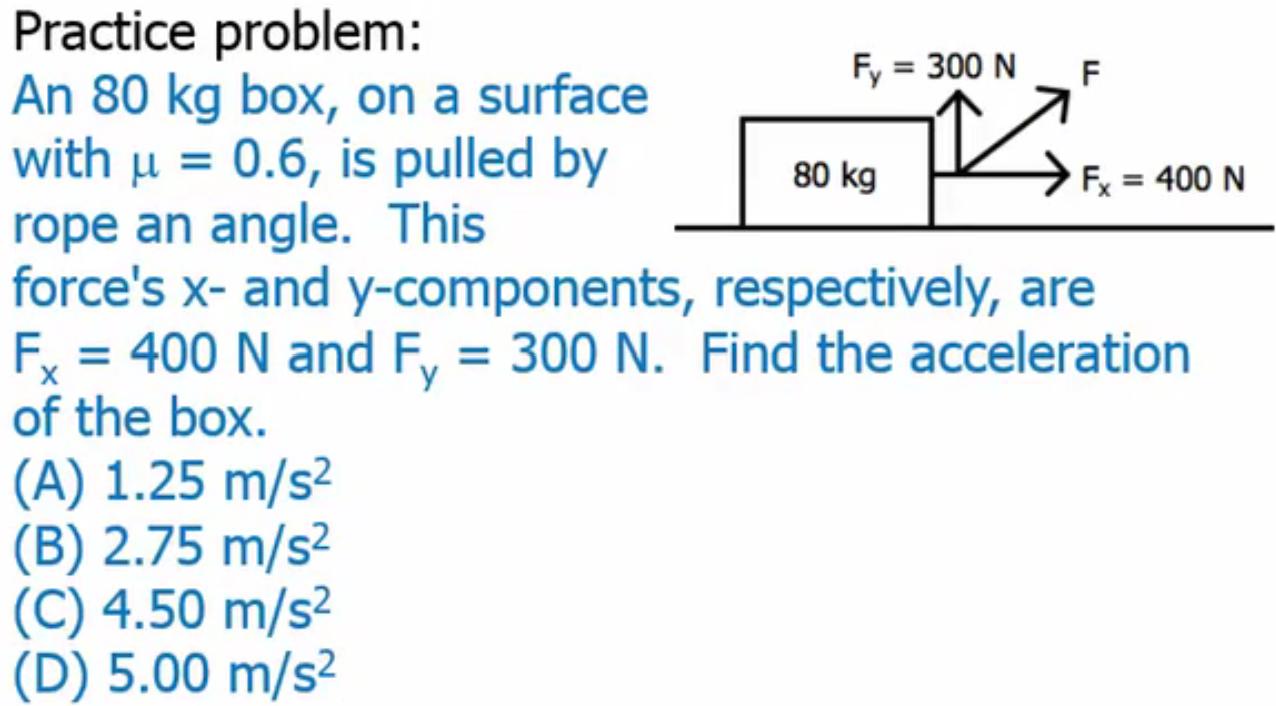
A) 1.25 m/s2
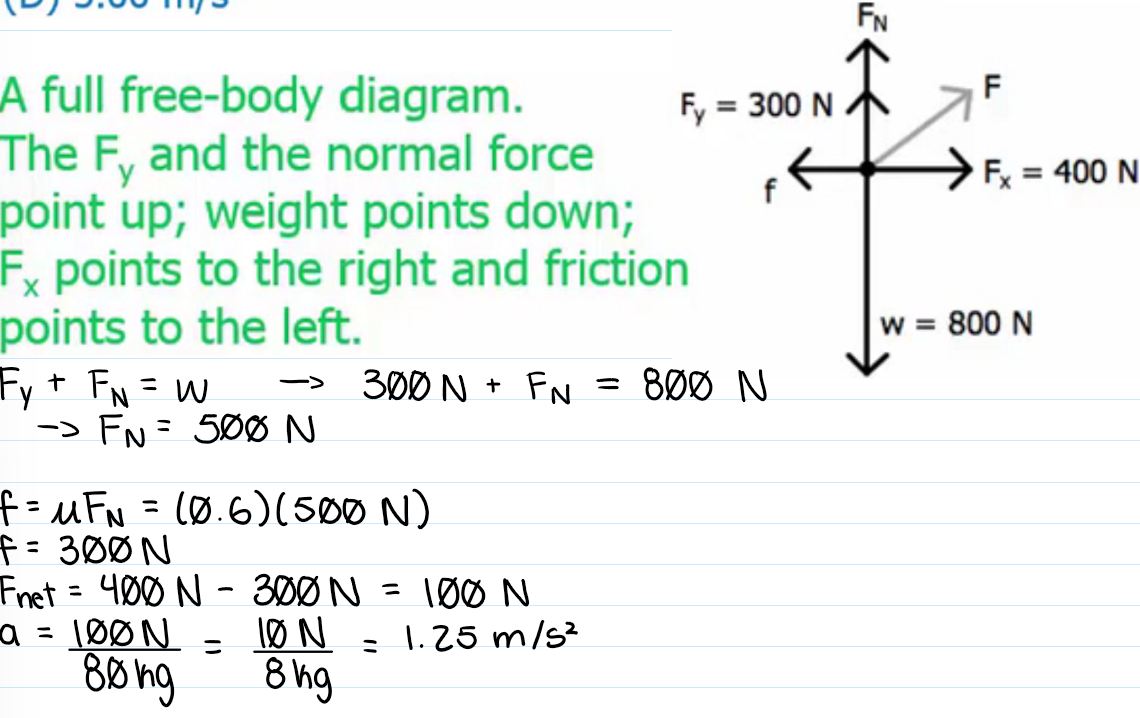
How to solve for inclines
Divide weight into two components
One perpendicular to the slope (wperp)
One parallel to the slope (wpar)
Low values of Theta, wperp would be bigger and wpar small
Values of Theta close to vertical, wpar would be large and wperp small
Can find wperp and wpar using SOHCAHTOA
wperp = w(cos(theta)) = mg(cos(theta))
wpar = w(sin(theta)) = mg(sin(theta))
Perpendicular Direction:
No motion at all
Forces are balanced
N = wperp = mg x cos(theta)
Friction Force in terms of wperp
N = wperp = mg x cos(theta)
f = uN = umg x cos(theta)
Equations connecting wperp and wpar
N = wperp = mg x cos(theta)
f = uN = umg x cos(theta)
Fnet = wpar - f
Fnet = mg x sin(theta) = umg x cos(theta)
Fnet = mg(sin(theta) - ucos(theta)) = ma → cancel out the m’s
g(sin(theta) - ucos(theta)) = a
Suppose the mass doesn’t slide:
If u2 is greater than or equal to tan(theta), the mass can sit on the incline
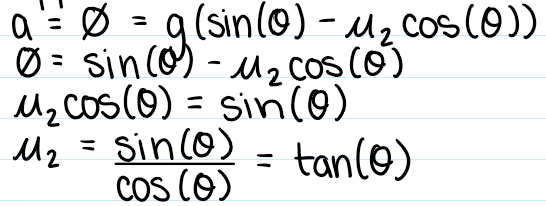
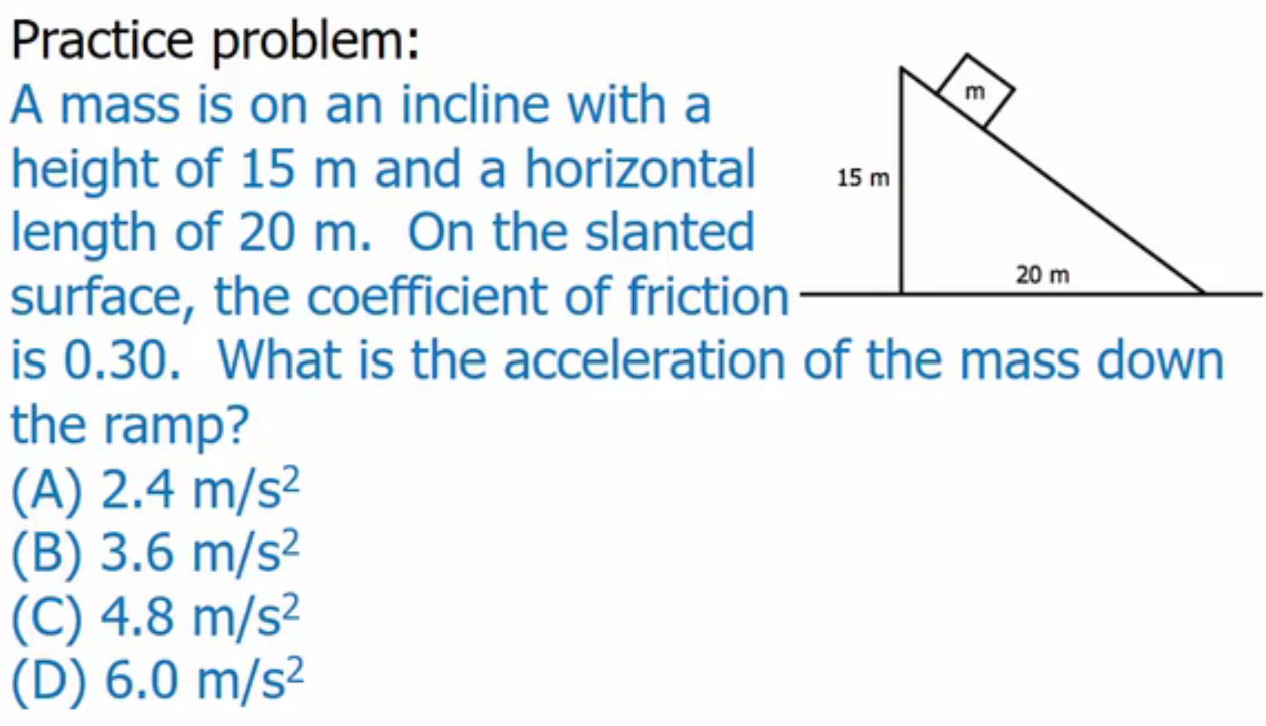
B) 3.6 m/s2
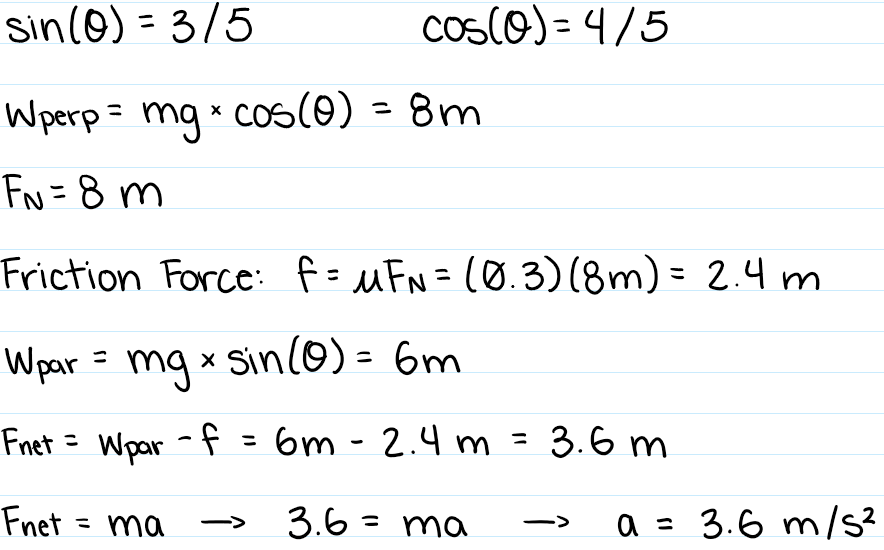
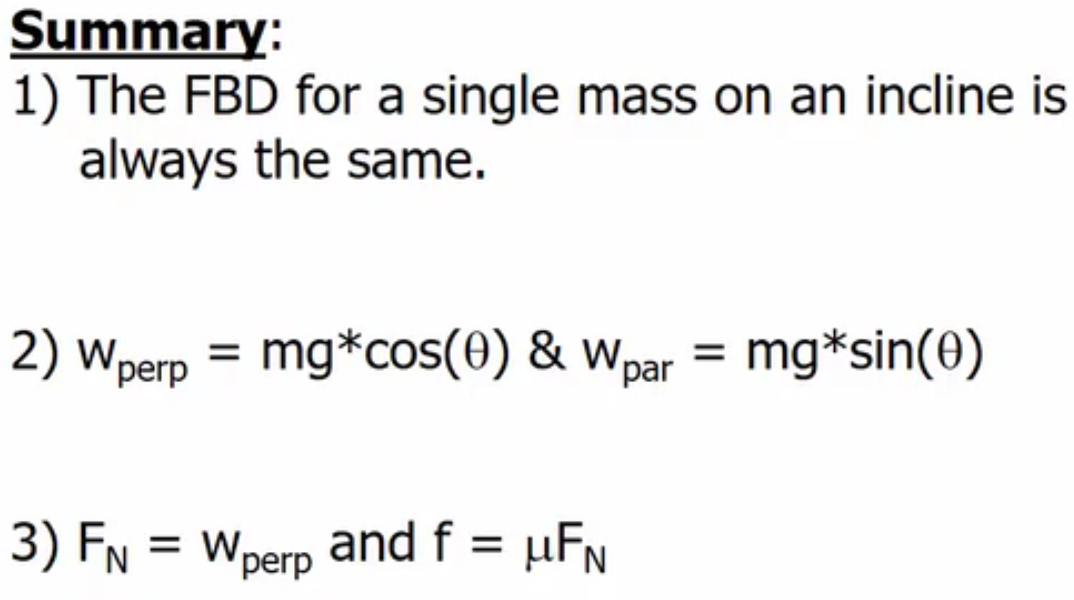
Balanced forces (N1) are two or more forces on the same object →
Equal & opposite forces on the same object always cancel
Action and reaction (N3) are always on two different objects →
They are always equal & opposite, but never cancel
Center of Mass Definition
All the mass of an object is concentrated at a single point
Changes as the body assumes different positions
Center of Mass Formula

If masses were spread over a 2D array, w/ x- and y-components:
xcm = sum of (mi)(xi) divided by total mass
ycm = sum of (mi)(yi) divided by total mass
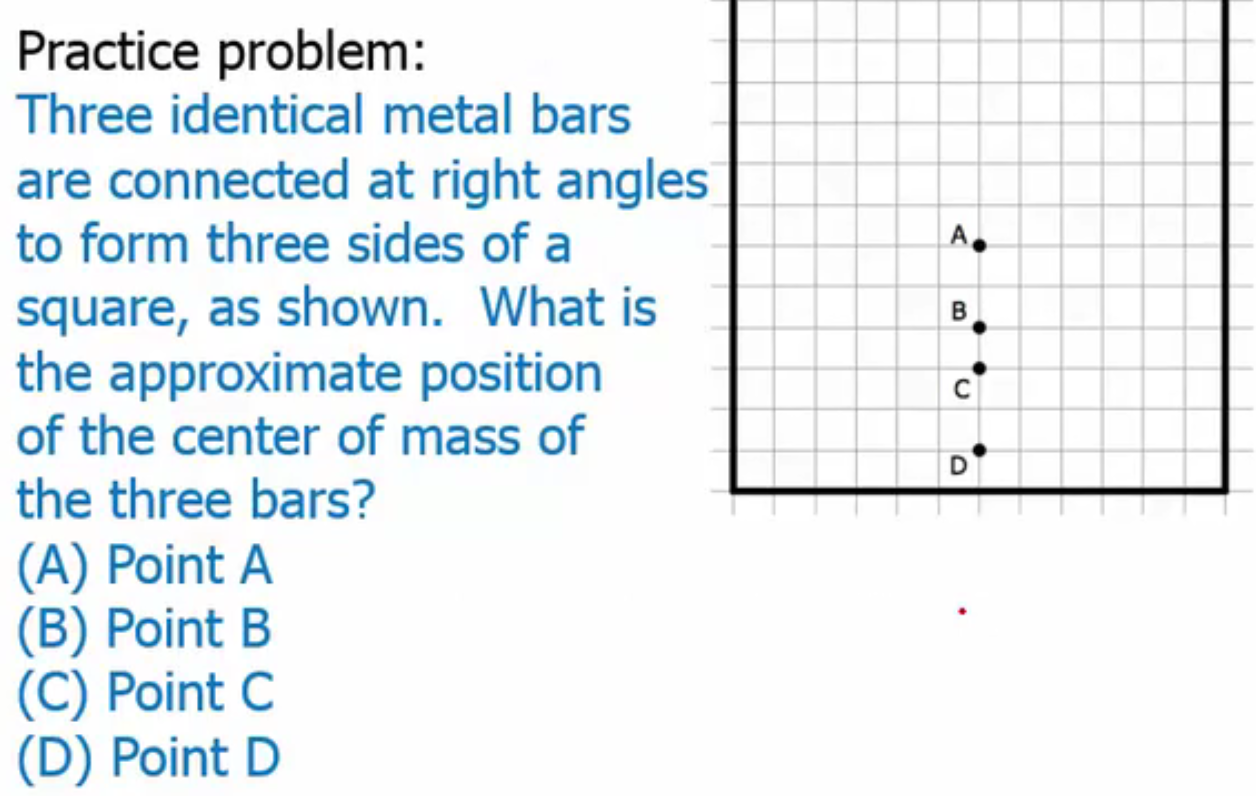
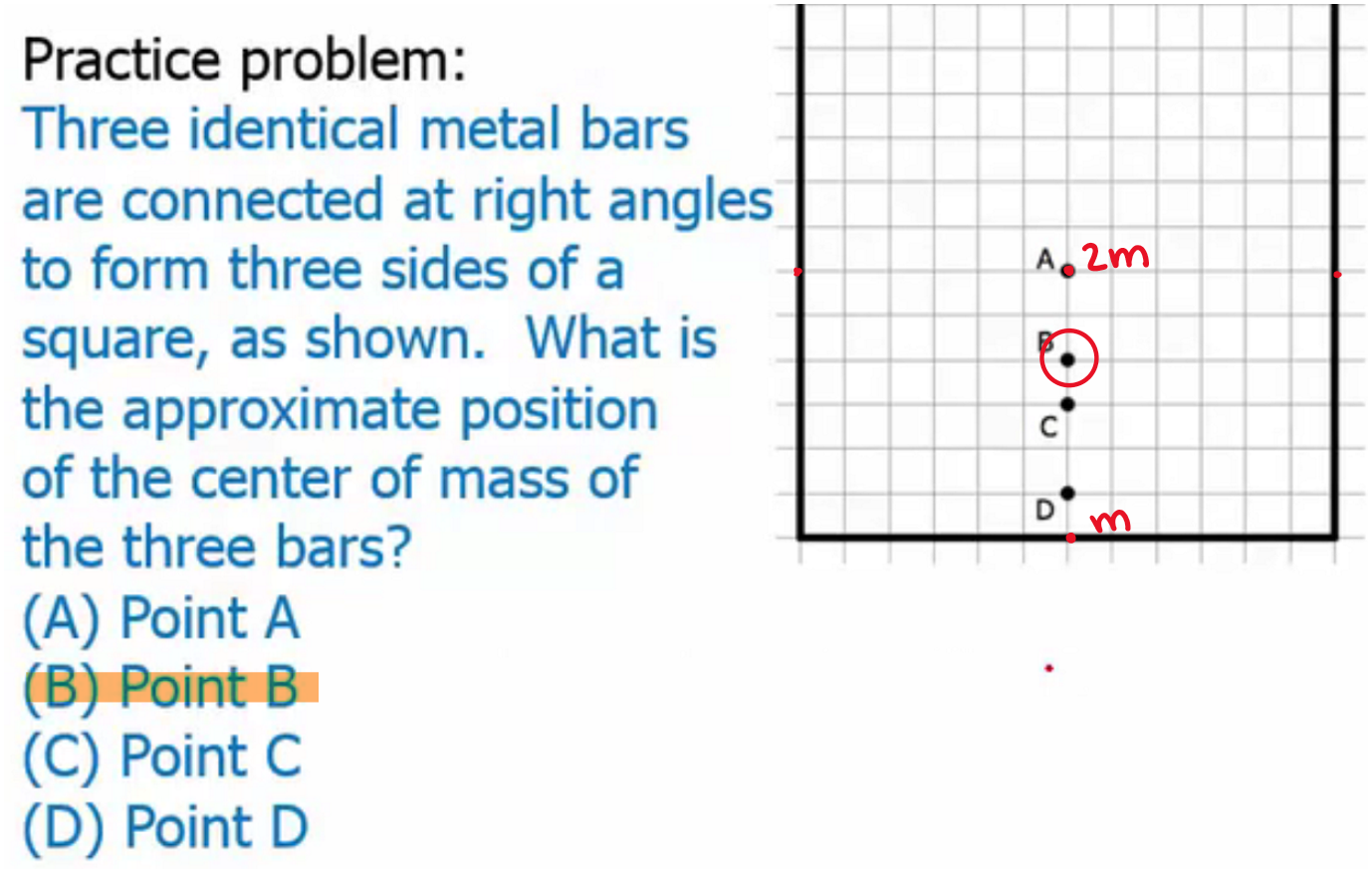
A force applied at the center of mass of an object will accelerate the object
A force applied offline from the center of mass can also twist or spin the object in addition to moving it
Torque (T)
A way to express the “leverage” that a force has because it acts at some radius from its target
T = Fr x sin(theta)
F = the force, which as a vector naturally has a direction
r = the displacement vector from the center of rotation tot he point where the force is applied (“distance”
theta: the angle between F and r
When theta = 90 degrees
F and r produce the maximum possible torque
When theta = 0 degrees or 180 degrees
sin(theta) = 0, so there is no torque at all because the force is exactly in line with the center
When torques are balanced:
Tccw = Tcw
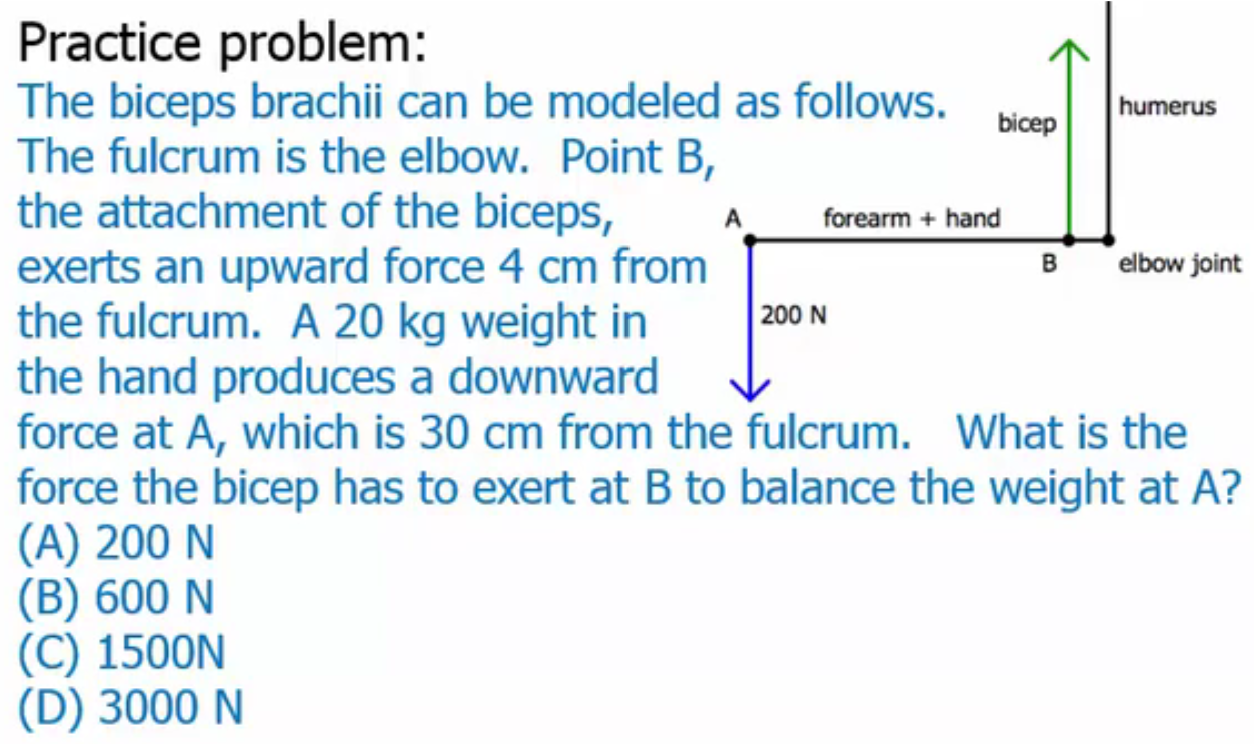
C) 1500 N
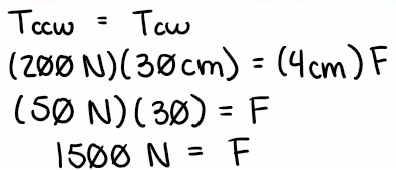
Statics:
The student of the forces in play when things are sitting still
For any physical object that is still, it must be true that:
All forces are balance (in all directions)
All torques are balanced
The two requirements result in two different equations for two unknowns
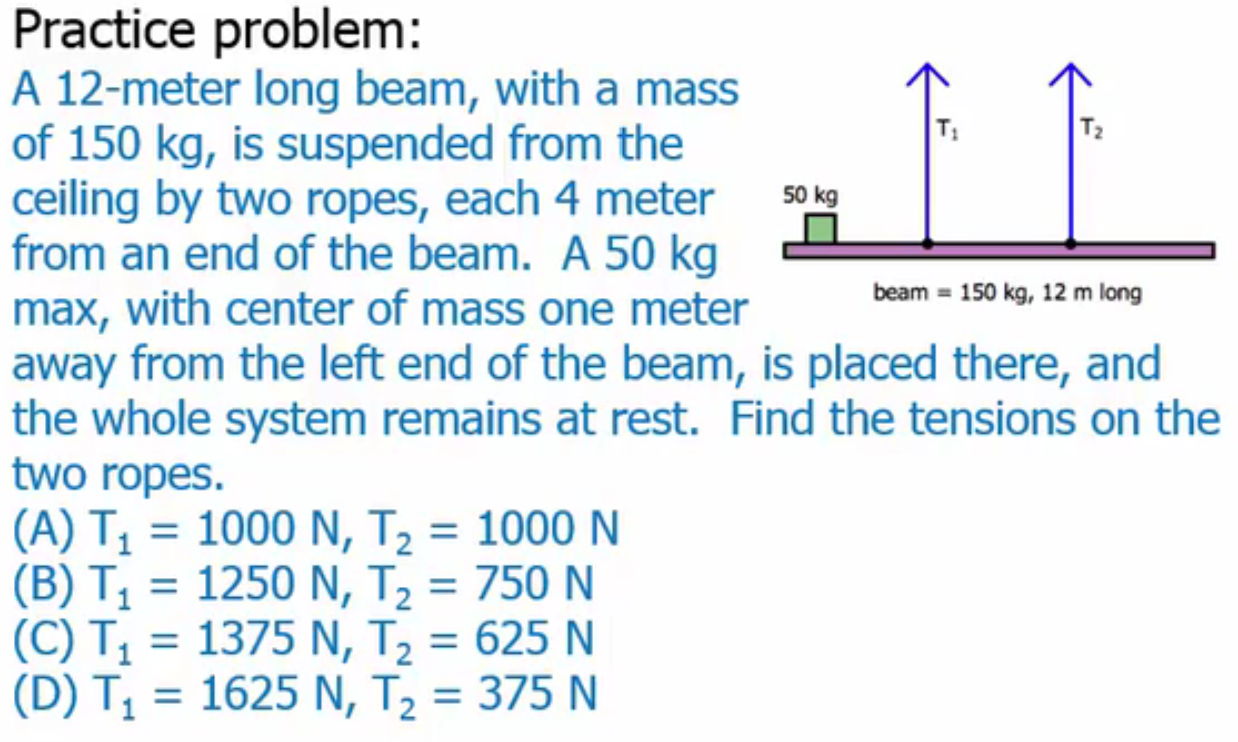
D) T1 = 1625 N, T2 = 375 N
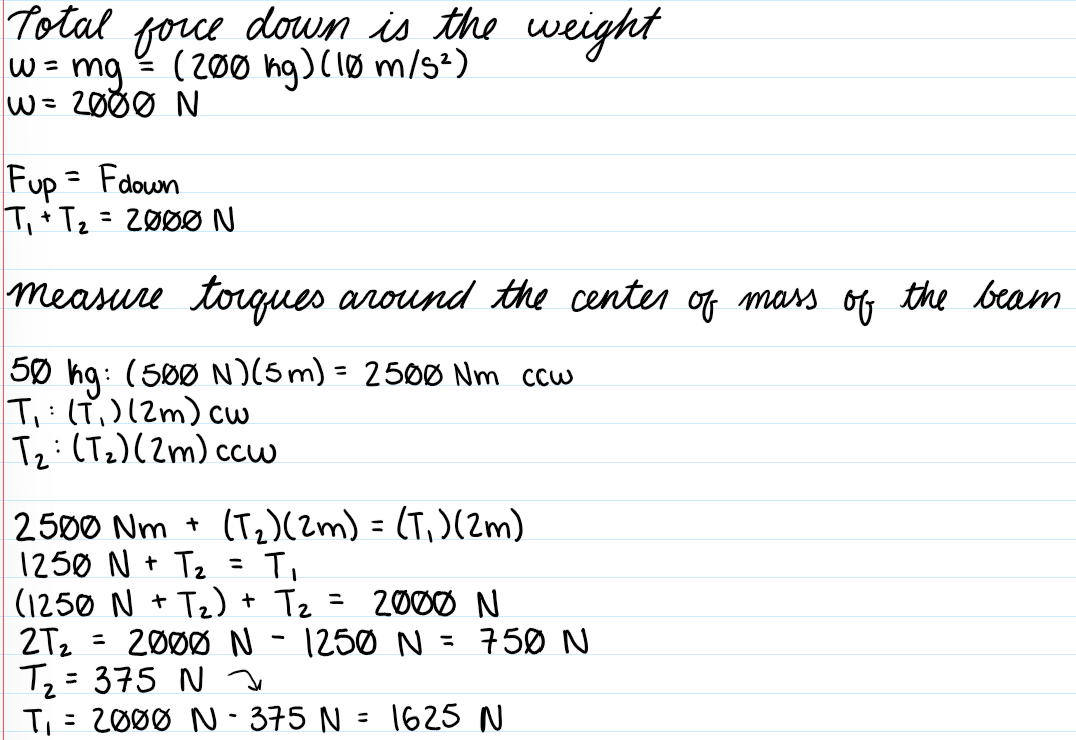
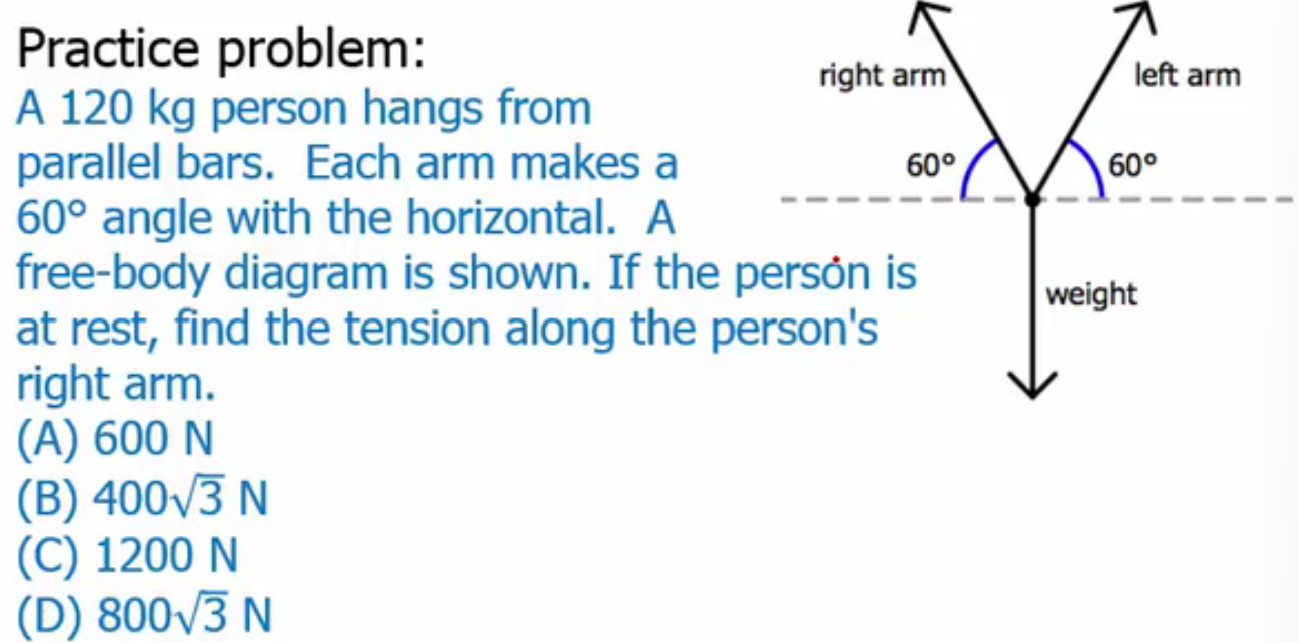
B) 400sqrt(3) N
Bilateral symmetry:
two x-components of the forces are equal and opposite, so they cancel out
two y-components of the forces from the arrows are equal and combine to an upward force that balances the weight

Energy Definition
The ability to do work
Lifting, moving objects, or changing their velocity
Units of Energy
Joules = N x m
Gravitational Potential Energy
GPE = Ug = m x g x h
Linear relationship with mass or height and energy
Depends on an object’s mass, gravity’s acceleration, and height
The lowest point in a problem has zero gravitational energy
Spring Potential Energy
SPE = Us = ½ k * x2
k = spring constant
Higher = less stretch
x = distance the spring is compressed or stretched
Greater stretch = more energy stored
Kinetic Energy
KE = ½ m * v2
An object’s energy increases with its mass and the square of its velocity
The heavier and faster the object = greater KE
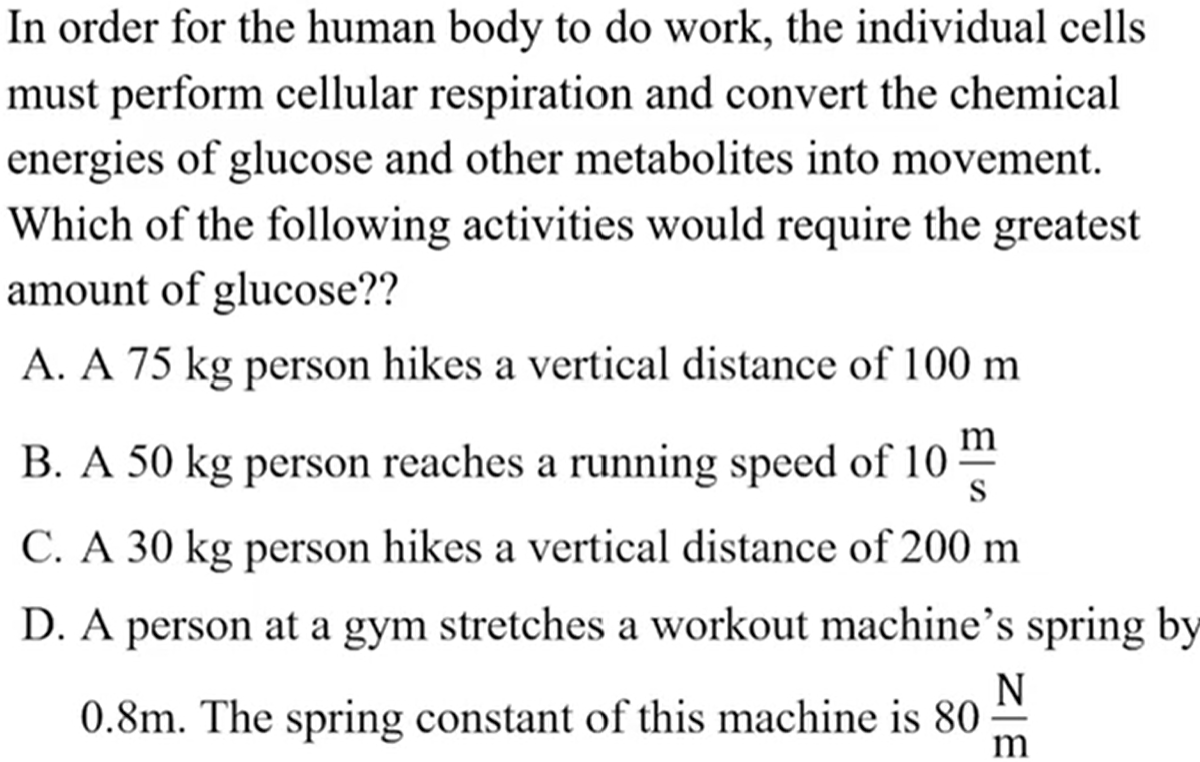
A. A 75 kg person hikes a vertical distance of 100 m